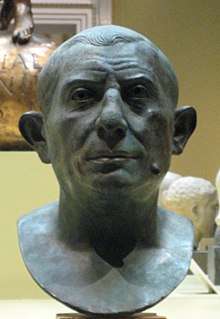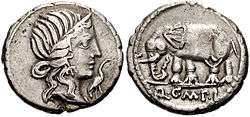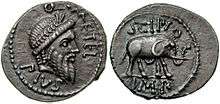Caecilia (gens)

The gens Caecilia was a plebeian[lower-roman 1] family at Rome. Members of this gens are mentioned in history as early as the fifth century BC, but the first of the Caecilii who obtained the consulship was Lucius Caecilius Metellus Denter, in 284 BC.[1][2]
Origin
Like other Roman families in the later times of the Republic, the Caecilii traced their origin to a mythical personage, Caeculus, the founder of Praeneste. He was said to be the son of Vulcan, and engendered by a spark; a similar story was told of Servius Tullius. He was exposed as an infant, but preserved by his divine father, and raised by maidens. He grew up amongst the shepherds, and became a highwayman. Coming of age, he called upon the people of the countryside to build a new town, convincing them with the aid of a miracle. An alternative tradition claimed that the Caecilii were descended from Caecas, one of the companions of Aeneas, who came with him to Italy after the sack of Troy.[3][4][5][1][6][7]
Praenomina
The praenomina used by the Caecilii during the Republic are Lucius, Quintus, Gaius, and Marcus. Titus appears only towards the very end of the Republic, and is not known to have been used by the great house of the Caecilii Metelli.
Branches and cognomina
The cognomina of this gens under the Republic are Bassus, Denter, Metellus, Niger, Pinna, and Rufus, of which the Metelli are the best known. From the consulship of Lucius Caecilius Metellus Denter, the family of the Metelli became one of the most distinguished at Rome. In the latter half of the second century BC, it obtained an extraordinary number of the highest offices of the state. Quintus Metellus, who was consul in 143 BC, had four sons, who were raised to the consulship in succession; and his brother, Lucius Metellus, who was consul in 142, had two sons, who were likewise elevated to the same dignity.
The Metelli were distinguished as a family for their unwavering support of the party of the optimates. The etymology of their name is quite uncertain. Festus connects it, probably from mere similarity of sound, with mercenarii. The history of the family is very difficult to trace, and in many parts conjectural. It is treated at length by Drumann.[8][9][10]
The victory of the consul L. Caecilius Metellus against Hasdrubal's elephants at Panormus in 251 seems to have left a durable impression on the Caecili Metelli, as many of them featured an elephant on the coins they minted. In fact, elephants are so often used on their coins that it might have become their emblem.[11]
Members
- This list includes abbreviated praenomina. For an explanation of this practice, see filiation.
Caecilii Metelli

- Gaius Caecilius (Metellus), grandfather of Lucius Caecilius Metellus, the consul of 251 BC, and perhaps the father of Lucius Caecilius Metellus Denter, consul in 284.
- Lucius Caecilius (C. f.) Metellus Denter, consul in 284 and praetor in 283 BC, slain in battle against the Senones.
- Lucius Caecilius L. f. C. n. Metellus, consul in 251 and 247 BC, during the First Punic War, and afterward Pontifex Maximus.
- Lucius Caecilius L. f. L. n. Metellus, tribune of the plebs in 213 BC, previously degraded by the censors for proposing to abandon Italy and establish a new colony after the Battle of Cannae.
- Quintus Caecilius L. f. L. n. Metellus, consul in 206 BC, during the Second Punic War.
- Marcus Caecilius L. f. L. n. Metellus, praetor urbanus in 206 BC.
- Lucius Caecilius Denter, praetor in 182 BC, obtained Sicilia for his province.[13]
- Marcus Caecilius Denter, one of the ambassadors sent to Perseus in 173 BC. to inspect the affairs of Macedonia, and to Alexandria to renew the friendship with Ptolemaeus.[14]
- Quintus Caecilius Q. f. L. n. Metellus, surnamed Macedonicus, triumphed over Andriscus, and became consul in 143 BC, and censor in 131.
- Lucius Caecilius Q. f. L. n. Metellus, surnamed Calvus, consul in 142 BC.
- Quintus Caecilius Q. f. Q. n. Metellus, consul in 123 and censor in 120 BC, conquered the Balearic Islands, receiving the surname Balearicus, and founded several cities there.
- Lucius Caecilius L. f. Q. n. Metellus, surnamed Dalmaticus, consul in 119 and censor in 115 BC, triumphed over the Dalmati, and later became Pontifex Maximus.
- Lucius Caecilius Q. f. Q. n. Metellus, surnamed Diadematus, consul in 117 BC.
- Marcus Caecilius Q. f. Q. n. Metellus, consul in 115 BC, triumphed over the Sardinians.
- Gaius Caecilius Q. f. Q. n. Metellus, surnamed Caprarius, consul in 113 and censor on 102 BC, triumphed over the Thracians.
- Caecilia Q. f. Q. n. Metella, married Gaius Servilius Vatia.
- Caecilia Q. f. Q. n. Metella, married Publius Cornelius Scipio Nasica Serapio.
- Quintus Caecilius L. f. Q. n. Metellus, surnamed Numidicus, consul in 109 and censor in 102 BC, triumphed over Jugurtha; expelled from the senate and exiled by Lucius Appuleius Saturninus, and not recalled for twenty years.
- Caecilia L. f. Q. n. Metella, wife of Lucius Licinius Lucullus, and mother of the younger Lucullus, the conqueror of Mithridates.
- Quintus Caecilius Q. f. Q. n. Metellus, surnamed Nepos, consul in 98 BC.
- Caecilia Q. f. Q. n. Metella, married Appius Claudius Pulcher, praetor in 88 BC.
- Caecilia L. f. L. n. Metella, married first Marcus Aemilius Scaurus, consul in 115 BC, and second Lucius Cornelius Sulla, the dictator.
- Quintus Caecilius Q. f. L. n. Metellus, surnamed Pius, one of Sulla's most successful generals, consul in 80 BC, and later Pontifex Maximus.
- Gaius Caecilius Metellus, a junior senator circa 80 BC.[15]
- Quintus Caecilius Metellus, surnamed Creticus, consul in 69 BC, triumphed over the Cretans.
- Lucius Caecilius Metellus, consul in 68 BC, died at the beginning of his year of office.
- Marcus Caecilius Metellus, praetor in 69 BC.
- Quintus Caecilius Metellus Creticus, perhaps quaestor circa 60 BC. with Gaius Trebonius.[16][17]
- Quintus Caecilius Q. f. Q. n. Metellus, surnamed Celer, consul in 60 BC.
- Quintus Caecilius Q. f. Q. n. Metellus Nepos, consul in 57 BC.
- Quintus Caecilius Q. f. Metellus Pius Scipio, the son of Publius Cornelius Scipio Nasica, adopted by Quintus Caecilius Metellus Pius; appointed consul suffectus from the kalends of Sextilis in 52 BC, and a partisan of Pompeius.
- Lucius Caecilius (L. f.) Metellus, tribunus plebis in 49 BC, opposed Caesar's attempt to take possession of the sacred treasury.[18][19][20][21][22][23]
- Marcus Caecilius (M. f.) Metellus, mentioned by Cicero in 60 BC.[24]
- Quintus Caecilius (Q. f. Q. n.) Metellus Creticus, consul in AD. 7.[25][26]
Others
- Gaia Caecilia, the legendary personification of Roman domesticity, frequently equated with Tanaquil, the wife of Tarquinius Priscus, the fifth King of Rome.[27]
- Quintus Caecilius, tribunus plebis in 439 BC.[28]
- Statius Caecilius, a comic poet of the early 2nd century BC.
- Caecilius Pinna, one of the Roman commanders during the Social War, is said to have defeated the Marsi in several battles, in conjunction with Lucius Licinius Murena. As he is not mentioned in other records, it may be that his proper name was Caecilius Pius, since Quintus Caecilius Metellus Pius played a distinguished part in this war.[29]
- Quintus Caecilius Niger, a Sicilian, and quaestor of Verres during his administration of Sicily. He contended with Cicero for the prosecution of Verres, pretending to be the enemy of his former master, but in reality desiring to deprive the Sicilians of Cicero's advocacy. Cicero's oration Divinatio in Caecilium was delivered against this Caecilius when the judices had to decide which should be given the prosecution.[30]
- Lucius Caecilius Rufus, half-brother of Publius Cornelius Sulla, was tribune of the plebs in BC 63, and proposed that both Sulla and Publius Autronius Paetus, who had been elected consuls for 66, but been convicted of bribery and condemned, should again be allowed to stand for office; however, Sulla convinced him to withdraw the proposal. Rufus was a supporter of Cicero and the aristocratic party, and opposed agrarian reform. He was praetor in 57, and proposed the recall of Cicero from banishment, incurring the wrath of Publius Clodius Pulcher.[31][32]
- Quintus Caecilius, an eques, slain by his brother-in-law, Catiline, in the time of Sulla.[33][34]
- Quintus Caecilius Metellus, an eques, who became wealthy as a moneylender, died in 57 BC, leaving his fortune to his nephew, Titus Pomponius Atticus.[35][36]
- Quintus Caecilius Bassus, an eques, and partisan of Gnaeus Pompeius, praetor in 46 BC.
- Titus Caecilius, primus pilus in the army of Lucius Afranius, killed at the Battle of Ilerda in 49 BC.[37]
- Caecilia, wife of the younger Publius Cornelius Lentulus Spinther, who divorced her in 45 BC.[38]
- Caecilia, the daughter of Titus Pomponius Atticus, married Marcus Vipsanius Agrippa.
- Quintus Caecilius Epirota, a grammarian, and freedman of Titus Pomponius Atticus.
- Titus Caecilius Eutychides, a freedman of Titus Pomponius Atticus, afterwards adopted by Quintus Caecilius.[39]
- Caecilius Calactinus, a Jewish Greek rhetorician at Rome in the time of Augustus.
- Gaius Caecilius Rufus, consul in AD 17.[40][41]
- Caecilius Cornutus, a man of praetorian rank in the reign of Tiberius, unjustly accused in connection with a plot against the Emperor, put an end to his own life.[42]
- Caecilius Bion, a writer on the properties of medicinal plants, used by Pliny the Elder.[43]
- Lucius Caecilius Jucundus, a banker at Pompeii during the first century AD, selected as the fictionalised subject of the Cambridge Latin Course.
- Quintus Caecilius L. f. Jucundus, elder son of the Pompeiian banker.
- Sextus Caecilius L. f. Jucundus Metellus, younger son of the Pompeiian banker.
- Caecilius of Elvira, or Saint Caecilius, traditional founder of the Archdiocese of Granada circa AD. 64.
- Gnaeus Caecilius Simplex, appointed consul suffectus Ex Kal. Nov. by the emperor Vitellius in AD. 69.[44][45]
- Caecilius Rufinus, expelled from the senate by Domitian because he danced.[46][47]
- Caecilius Clemens, a notary in Egypt mentioned between AD 86 and 100 in four papyri, notably Papyrus Oxyrhynchus 241 and 581.
- Aulus Caecilius Faustinus, consul suffectus in AD 99.
- Gaius Plinius Caecilius Secundus, or "Pliny the Younger", a writer and statesman during the late first and early second century. He was a member of gens Caecilia from birth, the son of Lucius Caecilius Cilo, and grandson of Gaius Caecilius. He was adopted by his maternal uncle, the scholar Gaius Plinius Secundus, or "Pliny the Elder", and changed his name accordingly.
- Quintus Caecilius Marcellus Dentilianus, consul suffectus around AD 150.[48]
- Sextus Caecilius, a jurist, who may or may not be identical with Sextus Caecilius Africanus.
- Sextus Caecilius Africanus, a jurist during the latter half of the second century
- Caecilius, a writer of Argos on the art of fishing.[49]
- Caecilia, or Saint Cecilia, a semi-legendary matron of Rome, and Christian martyr under Alexander Severus, circa AD 230. Modern historians suspect that she was executed during the reign of Marcus Aurelius.
- Caecilia Paulina, Roman empress during the Crisis of the Third Century. She was the wife of Maximinus Thrax, and mother of Gaius Julius Verus Maximus. She probably died in 236, as Maximinus had her deified that year. Almost nothing is known about her, as most of the works dealing with the reign of Maximinus have been lost.
- Caecilius Natalis, the person who maintains the cause of paganism in the dialogue of Marcus Minucius Felix, entitled Octavius.[50][51]
- Thascius Caecilius Cyprianus, a Christian philosopher, who became Bishop of Carthage, was martyred, and sanctified as Saint Cyprian.
- Lucius Caecilius Firmianus Lactantius, a Christian author and advisor to Emperor Constantine the Great (reigned 306-337).
Footnotes
- ↑ The appearance of Titus Caecilius, a patrician consular tribune for the year 444 BC in Livy, is a false reading for Titus Cloelius.
See also
References
- 1 2 Dictionary of Greek and Roman Biography and Mythology, vol. I, p. 526 ("Caecilia Gens").
- ↑ Livy, iv. 7.
- ↑ Festus, s. v. Caeculus.
- ↑ Servius, vii. 678.
- ↑ Solinus, ii. 9.
- ↑ Hartung, Die Religion der Römer, vol. i, pp. 88 ff.
- ↑ Klausen, Aeneas und die Penaten, pp. 761 ff.
- ↑ Dictionary of Greek and Roman Biography and Mythology, vol. II, pp. 1055, 1056 ("Metellus").
- ↑ Festus, p. 146 (ed. Müller).
- ↑ Drumann, Geschichte Roms, vol. ii, pp. 17–58.
- ↑ Crawford, Roman Republican Coinage, pp. 287, 288, 292, 293, 387, 388, 390, 471.
- ↑ Crawford, Roman Republican Coinage, p. 390.
- ↑ Livy, xxxix. 56, xl. 1.
- ↑ Livy, xlii. 6.
- ↑ Waterfield, Plutarch: Roman Lives, p. 481.
- ↑ Drumann, Geschichte Roms, ii. 57.
- ↑ Cicero, Epistulae ad Familiares, xv. 21. § 2.
- ↑ Plutarch, "The Life of Caesar", 35, "The Life of Pompeius", 62.
- ↑ Cassius Dio, xli. 17.
- ↑ Appian, Bellum Civile, ii. 41.
- ↑ Caesar, De Bello Civili, i. 33.
- ↑ Lucan, iii. 114 ff.
- ↑ Cicero, Epistulae ad Atticum, x. 4, 8.
- ↑ Cicero, Epistulae ad Atticum, ii. 1. § 1.
- ↑ Cassius Dio, lv. 30.
- ↑ Fasti Capitolini, AE 1927, 101; 1940, 59, 60.
- ↑ Pliny the Elder, vii. 74.
- ↑ Livy, iv. 16.
- ↑ Livy, Epitome, 76.
- ↑ Cicero, Divinatio in Caecilium.
- ↑ Cicero, Pro Sulla, 22, 23; Post Reditum in Senatu, 9; Pro Milone 14; Epistulae ad Quintum Fratrem, iii. 3. § 2.
- ↑ Asconius Pedianus, In Ciceronis Pro Milone, p. 48 (ed. Orelli).
- ↑ Quintus Tullius Cicero, De Petitione Consulatus, 2.
- ↑ Asconius Pedianus, In Ciceronis In Toga Candida, 84 (ed. Orelli).
- ↑ Cornelius Nepos, The Life of Atticus, 5.
- ↑ Cicero, Epistulae ad Atticum, i. 1, 12, ii. 19, 20, iii. 20.
- ↑ Caesar, De Bello Civili, i. 46.
- ↑ Cicero, Epistulae ad Atticum, xi. 23, xii. 52, xiii. 7.
- ↑ Cicero, Epistulae ad Atticum, iv. 15.
- ↑ Tacitus, Annales, ii. 41.
- ↑ Cassius Dio, lvii. 17.
- ↑ Tacitus, Annales, iv. 28.
- ↑ Pliny the Elder, xxviii. 57.
- ↑ Tacitus, Historiae, ii. 60, iii. 68.
- ↑ Cassius Dio, lxv. 17.
- ↑ Cassius Dio, lxvii. 13.
- ↑ Suetonius, "The Life of Domitian", 8.
- ↑ Alföldy, Konsulat und Senatorenstand unter der Antoninen, pp. 202 ff.
- ↑ Athenaeus, Deipnosophistae, i. 13.
- ↑ Minucius Felix, Octavius.
- ↑ Bähr, Die Christlich-Römische Theologie, § 19.
Bibliography

- Marcus Tullius Cicero, Divinatio in Quintum Caecilium, Epistulae ad Atticum, Epistulae ad Familiares, Epistulae ad Quintum Fratrem, Post Reditum in Senatu, Pro Milone, Pro Sulla.
- Quintus Tullius Cicero, De Petitione Consulatus (attributed).
- Gaius Julius Caesar, Commentarii de Bello Civili (Commentaries on the Civil War).
- Cornelius Nepos, De Viris Illustribus (On the Lives of Famous Men).
- Titus Livius (Livy), History of Rome.
- Marcus Annaeus Lucanus (Lucan), Pharsalia.
- Quintus Asconius Pedianus, Commentarius in Oratio Ciceronis In Toga Candida (Commentary on Cicero's Oration In Toga Candida), Commentarius in Oratio Ciceronis Pro Milone (Commentary on Cicero's Oration Pro Milone).
- Gaius Plinius Secundus (Pliny the Elder), Historia Naturalis (Natural History).
- Publius Cornelius Tacitus, Annales, Historiae.
- Plutarchus, Lives of the Noble Greeks and Romans.
- Gaius Suetonius Tranquillus, De Vita Caesarum (Lives of the Caesars, or The Twelve Caesars).
- Appianus Alexandrinus (Appian), Bellum Civile (The Civil War).
- Sextus Pompeius Festus, Epitome de M. Verrio Flacco de Verborum Significatu (Epitome of Marcus Verrius Flaccus' On the Meaning of Words).
- Athenaeus, Deipnosophistae (The Banquet of the Learned).
- Lucius Cassius Dio Cocceianus (Cassius Dio), Roman History.
- Gaius Julius Solinus, De Mirabilis Mundi (On the Wonders of the World).
- Marcus Minucius Felix, Octavius.
- Maurus Servius Honoratus (Servius), Ad Virgilii Aeneidem Commentarii (Commentary on Vergil's Aeneid).
- Johann Adam Hartung, Die Religion der Römer (The Religion of the Romans), Palm und Enke, Erlangen (1836).
- Johann Christian Felix Bähr, Die Christlich-Römische Theologie, Christian Friedrich Müller, Karlsruhe (1837).
- Rudolf Heinrich Klausen, Aeneas und die Penaten, Friedrich and Andreas Perthes, Hamburg and Gotha (1839).
- Wilhelm Drumann, Geschichte Roms in seinem Übergang von der republikanischen zur monarchischen Verfassung, oder: Pompeius, Caesar, Cicero und ihre Zeitgenossen, Königsberg (1834–1844).
- Dictionary of Greek and Roman Biography and Mythology, William Smith, ed., Little, Brown and Company, Boston (1849).
- Michael Crawford, Roman Republican Coinage, Cambridge University Press (1974, 2001).
- Géza Alföldy, Konsulat und Senatorenstand unter der Antonien (The Consulate and Senatorial State under the Antonines), Rudolf Habelt, Bonn (1977).
- Robin Waterfield, Plutarch: Roman Lives, Oxford University Press (1999).
![]()
- ↑ Crawford, Roman Republican Coinage, p. 471.